Trip to China - March
2003
Beijing
A short summary
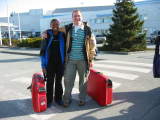 This
is a travelogue about the trip that my wife, Nikki, and I took to China
(Beijing, Xi’an and Hong Kong) in the period from March 15th to March
29th 2003. We first spent 7 days in Beijing and we got to see the Great
Wall, the Forbidden City, Temple of Heaven, the Summer Palace and so on.
From Beijing we took an overnight train to Xi’an and our main goal there
was to see the Terra-Cotta Warriors but we also got to see a few other
things. And from Xi’an we flew to the city of Shenzhen and from there we
took the boat to Hong Kong (HK), where we stayed for about 5 days. In HK
we visited Ocean Park, Victoria Peak, the Space Museum and so on.
This
is a travelogue about the trip that my wife, Nikki, and I took to China
(Beijing, Xi’an and Hong Kong) in the period from March 15th to March
29th 2003. We first spent 7 days in Beijing and we got to see the Great
Wall, the Forbidden City, Temple of Heaven, the Summer Palace and so on.
From Beijing we took an overnight train to Xi’an and our main goal there
was to see the Terra-Cotta Warriors but we also got to see a few other
things. And from Xi’an we flew to the city of Shenzhen and from there we
took the boat to Hong Kong (HK), where we stayed for about 5 days. In HK
we visited Ocean Park, Victoria Peak, the Space Museum and so on.
Prelude
A couple of years back we thought about going to China and as luck
would have it we ended up in Florida instead
:-). Well, this time around we were more determined and we wanted to go
to China before the preparations for the Olympics in 2008 ”ruin” the
city of Beijing. We also wanted to see the Terra-Cotta Warriors in Xi’an
and we have also always wanted to see Hong Kong and that is how we came
up with our travel plan.
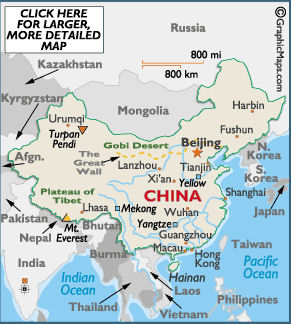 |
|
Map provided by: www.worldatlas.com |
The tickets for the trip were bought through Kinareiser in Norway which included the flight (to Beijing and back from Hong Kong) and 6 nights at the Radisson SAS Hotel in Beijing. Apart from this it was up to us. We paid about 7500 Norwegian Kroner pr. person for the tickets (about €960, 1€=7.8 Kroner).We planned the trip by firstly buying a couple of books: CADOGAN book about Beijing written by Peter Neville-Hadley and Lonely Planet’s guide to Hong Kong & Macau. Mr. Neville-Hadley seems to be quite an authority of sorts when it comes to China because his name pops up on newsgroups and different internet forums. And his book is very detailed when it comes to many aspects of Beijing. The Lonely Planet guide is quite boring but I guess that is because I’m used to the Eyewitness guides. And we did of course get some information from the internet.
The trip begins
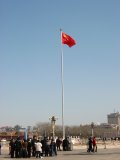 We wanted to fly SAS (Scandinavian Airlines) this time but they
didn’t have the option of flying to Beijing and back from Hong Kong so
we ended up on KLM. As I have said before, I think that KLM has gone
down in quality in the last few years. When we boarded the plane it was
pretty full and one lady didn’t know where to place her hand baggage and
she asked one of the air stewardesses if she could help her out. And the
KLM stewardess just said ”No”. Not much service to be found there. But
hey, KLM do have a great home airport at least. Schiphol has become a
really nice airport and you can do a lot of shopping there. When we were waiting to board the plane we hoped that there would be
some empty seats but for the first time I got to experience an
over-booked flight. They started offering people € 350 to go via Seoul
instead and arrive in Beijing 6 hours later than first scheduled. It was
tempting but we stuck to the original flight.
We wanted to fly SAS (Scandinavian Airlines) this time but they
didn’t have the option of flying to Beijing and back from Hong Kong so
we ended up on KLM. As I have said before, I think that KLM has gone
down in quality in the last few years. When we boarded the plane it was
pretty full and one lady didn’t know where to place her hand baggage and
she asked one of the air stewardesses if she could help her out. And the
KLM stewardess just said ”No”. Not much service to be found there. But
hey, KLM do have a great home airport at least. Schiphol has become a
really nice airport and you can do a lot of shopping there. When we were waiting to board the plane we hoped that there would be
some empty seats but for the first time I got to experience an
over-booked flight. They started offering people € 350 to go via Seoul
instead and arrive in Beijing 6 hours later than first scheduled. It was
tempting but we stuck to the original flight.
Arriving in Beijing
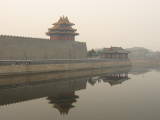 Having left Stavanger on Saturday and flown via Amsterdam, we landed
at Beijing airport at about 9 am on Sunday morning. I was hoping that we
would get a view of the city but it was so misty that we didn’t see
anything until 5 seconds prior to landing. The airport itself looked
nice and well kept and getting through immigration was pretty effective.
The first thing I noticed when I picked up my suitcase (on its maiden
voyage by the way) was that it was damaged as if someone had taken a
crowbar to its side. I went to the luggage centre to report it and was
refunded 400 RMB. RMB is the local currency and it is known as Renminbi
(people's money) and is often abbreviated as RMB….the unit of Renminbi
is a yuan by the way.
Having left Stavanger on Saturday and flown via Amsterdam, we landed
at Beijing airport at about 9 am on Sunday morning. I was hoping that we
would get a view of the city but it was so misty that we didn’t see
anything until 5 seconds prior to landing. The airport itself looked
nice and well kept and getting through immigration was pretty effective.
The first thing I noticed when I picked up my suitcase (on its maiden
voyage by the way) was that it was damaged as if someone had taken a
crowbar to its side. I went to the luggage centre to report it and was
refunded 400 RMB. RMB is the local currency and it is known as Renminbi
(people's money) and is often abbreviated as RMB….the unit of Renminbi
is a yuan by the way.
On the money topic: once again we travelled “without” any money. The only thing we had was our VISA and MasterCard. And as we had read on the net there are ATM’s once you get out of customs.
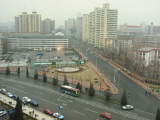 I
didn’t really know what to expect from Beijing. Sure, I knew about the
great wall and the Forbidden City but what would the city itself be
like? And going from the airport to the hotel I got a bit sceptical. It
was misty, raining and everything looked greyish and boring (just like
it does here in Norway in the winter time). And the taxi was driving
really slowly on the highway - as if the driver was trying to save
petrol or something. But the drive didn’t take long and it only cost us
about 50 RMB.
I
didn’t really know what to expect from Beijing. Sure, I knew about the
great wall and the Forbidden City but what would the city itself be
like? And going from the airport to the hotel I got a bit sceptical. It
was misty, raining and everything looked greyish and boring (just like
it does here in Norway in the winter time). And the taxi was driving
really slowly on the highway - as if the driver was trying to save
petrol or something. But the drive didn’t take long and it only cost us
about 50 RMB.
The Radisson SAS Hotel was nice but not centrally located. Getting around was not a big problem because there were always taxis available. If you would like further details about the hotel you can check out my review of the hotel here.
Tiananmen Square
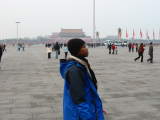 Our
plan was to start the sight-seeing right away but the long flight had
worn us out. We ended up taking a short nap before getting started. The
first place that we could think of was Tiananmen Square :-) 15 minutes
in a taxi and 30 RMB later we got to Tiananmen Square. The Square is
HUGE and it is quite impressive. Our late arrival to the Square meant
that we, together with lots of other Chinese people, were able to
witness the daily ceremony of the lowering the Chinese flag. It can be pretty cold in Beijing in March
by the way. On most days it would be
freezing in the morning and the evening and in the middle of the day we
would have about 10-12 degrees Celsius. So I was glad that I had brought
my fleece and Gore-Tex jacket :-)
Our
plan was to start the sight-seeing right away but the long flight had
worn us out. We ended up taking a short nap before getting started. The
first place that we could think of was Tiananmen Square :-) 15 minutes
in a taxi and 30 RMB later we got to Tiananmen Square. The Square is
HUGE and it is quite impressive. Our late arrival to the Square meant
that we, together with lots of other Chinese people, were able to
witness the daily ceremony of the lowering the Chinese flag. It can be pretty cold in Beijing in March
by the way. On most days it would be
freezing in the morning and the evening and in the middle of the day we
would have about 10-12 degrees Celsius. So I was glad that I had brought
my fleece and Gore-Tex jacket :-)
While
at the square we got in touch with some locals - a brother and a sister,
and the girl spoke pretty good English. We conversed with them for a
while, whilst waiting to see the flag lowering. Having seen that we
continued to walk and talk with the two we had met. We ended up being
guided through some hútòngs. Hútòng is the Mandarin word for an alley
and describes the small alleyways of the traditional living quarters in
Chinese cities.
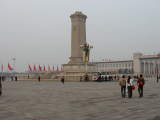 According
to our ”guides” the hútòngs south of the Square are in danger of being
demolished as a part of the preparations for the Olympics in 2008. We
walked around in this area and ate at a small restaurant. I understand
that there are quite a lot of old buildings in Beijing that don’t have
any toilets and public toilets are the solution. So when I needed to go
to the toilet, the restaurant only had a public toilet that I could use.
I went into a dark hall with only a single light bulb illuminating the
place. The ‘toilets’ were at the end of a hall where I discovered that
there were not even squatting toilets, just holes in the floor. The lack
of doors made privacy impossible. So one can say that it is quite
different to what I’m used to back home :-)
According
to our ”guides” the hútòngs south of the Square are in danger of being
demolished as a part of the preparations for the Olympics in 2008. We
walked around in this area and ate at a small restaurant. I understand
that there are quite a lot of old buildings in Beijing that don’t have
any toilets and public toilets are the solution. So when I needed to go
to the toilet, the restaurant only had a public toilet that I could use.
I went into a dark hall with only a single light bulb illuminating the
place. The ‘toilets’ were at the end of a hall where I discovered that
there were not even squatting toilets, just holes in the floor. The lack
of doors made privacy impossible. So one can say that it is quite
different to what I’m used to back home :-)
The Forbidden City
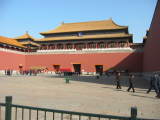 The
next day we were ready to check out one of the attractions that I was
most looking forward to:
The Forbidden City (Imperial Palace). This is
located north of Tiananmen Square and the Palace Museum takes up quite a
big space…the outer walls are about 1 km by 0.75 km in size and this was
once the home of the emperor, the empress, concubines, eunuchs and so
on.
The
next day we were ready to check out one of the attractions that I was
most looking forward to:
The Forbidden City (Imperial Palace). This is
located north of Tiananmen Square and the Palace Museum takes up quite a
big space…the outer walls are about 1 km by 0.75 km in size and this was
once the home of the emperor, the empress, concubines, eunuchs and so
on.
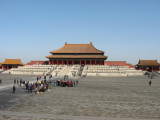 We bought tickets to the museum for 40 RMB (about € 5) and for
another 40 RMB and
my driver’s licence as a deposit, we rented audio-guides that helped us
with information throughout the museum. It was kinda funny to listen to
the audio-guide because the information was being narrated by James
Bond….eh…I mean Roger Moore :-)
We bought tickets to the museum for 40 RMB (about € 5) and for
another 40 RMB and
my driver’s licence as a deposit, we rented audio-guides that helped us
with information throughout the museum. It was kinda funny to listen to
the audio-guide because the information was being narrated by James
Bond….eh…I mean Roger Moore :-)
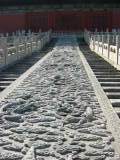 It was certainly handy as not all the
signs went into as much historical detail. We
were lucky enough to have great weather this day - the blue skies made
the yellow roof tiles looked even more majestic. The Forbidden City was
overwhelming – in size and historical facts – which I could bombard you
with but I think that I will summarise by saying that it was a great
experience In my opinion, this place can be compared to other
magnificent buildings such as Versailles. And with names like Gate of
Supreme Harmony, Hall of Protective Harmony and Hall of Heavenly Peace
you know that this was a place fit for an emperor.
It was certainly handy as not all the
signs went into as much historical detail. We
were lucky enough to have great weather this day - the blue skies made
the yellow roof tiles looked even more majestic. The Forbidden City was
overwhelming – in size and historical facts – which I could bombard you
with but I think that I will summarise by saying that it was a great
experience In my opinion, this place can be compared to other
magnificent buildings such as Versailles. And with names like Gate of
Supreme Harmony, Hall of Protective Harmony and Hall of Heavenly Peace
you know that this was a place fit for an emperor.
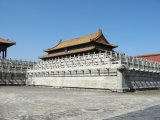 The
only negative thing about the Forbidden City, that I can think of, was
that on a few occasions we were approached by ”Chinese Art students”
claiming that they would have an exhibition in Norway soon and they
wanted us to come along to look at their paintings to get feedback and
new ideas. We never did go along to see what it was all about so I can’t
really comment on it :-) I was also surprised to see that a majority of
the Forbidden City’s visitors were of Chinese tour groups – either
following a flag holding tour leader, or browsing about in matching
hats.
The
only negative thing about the Forbidden City, that I can think of, was
that on a few occasions we were approached by ”Chinese Art students”
claiming that they would have an exhibition in Norway soon and they
wanted us to come along to look at their paintings to get feedback and
new ideas. We never did go along to see what it was all about so I can’t
really comment on it :-) I was also surprised to see that a majority of
the Forbidden City’s visitors were of Chinese tour groups – either
following a flag holding tour leader, or browsing about in matching
hats.
Temple of Heaven
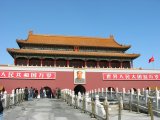 Still in high spirits, we made our way across Tiananmen Square in
the direction of the Temple of Heaven (know as Tiãn Tán Gõngyuán). For
30 RMB you can get into this park and check out ”Hall of the prayer for
good harvests”, ”Imperial vault of heaven” and ”Circular mound”. We
entered the park from the west and it took us quite a long time just to
walk to the centre of the park where we could check out the buildings.
The ”Hall of the prayer for good harvests” is a circular temple painted
in blue, green, gold and red and it was striking to see this temple
against the blue sky background.
Still in high spirits, we made our way across Tiananmen Square in
the direction of the Temple of Heaven (know as Tiãn Tán Gõngyuán). For
30 RMB you can get into this park and check out ”Hall of the prayer for
good harvests”, ”Imperial vault of heaven” and ”Circular mound”. We
entered the park from the west and it took us quite a long time just to
walk to the centre of the park where we could check out the buildings.
The ”Hall of the prayer for good harvests” is a circular temple painted
in blue, green, gold and red and it was striking to see this temple
against the blue sky background.
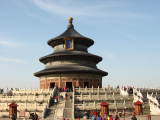 From this temple we walked south to get
to ”Imperial vault of heaven”. According to our guide book this has a
perfect circular wall and just like the Whispering gallery at St. Paul’s
in London one can stand on one side and talk to people on the other
side. Our guide book also mentioned that trying this out may be tricky
as we could expect quite a few loud Chinese trying it too*grin*
Fortunately, it was not crowded that day. Nikki and I went to a side
each and all of a sudden I hear Nikki’s voice saying ”G, can you hear
me?”. I was quite surprised and said ”Yes” and I think Nikki was even
more surprised than me because all she could say was ”Really??”.
From this temple we walked south to get
to ”Imperial vault of heaven”. According to our guide book this has a
perfect circular wall and just like the Whispering gallery at St. Paul’s
in London one can stand on one side and talk to people on the other
side. Our guide book also mentioned that trying this out may be tricky
as we could expect quite a few loud Chinese trying it too*grin*
Fortunately, it was not crowded that day. Nikki and I went to a side
each and all of a sudden I hear Nikki’s voice saying ”G, can you hear
me?”. I was quite surprised and said ”Yes” and I think Nikki was even
more surprised than me because all she could say was ”Really??”.
Jingshan Park
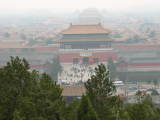 It is quite hard to comprehend how big the Forbidden City is and we
had read that if we wanted a nice view of the palace we could go to the
Jingshan Park which is located north of the Forbidden City. The park is
actually a little peak made up from all the material that were left over
when construction the moat around the Forbidden City. Unfortunately, we
went into the park on a misty day and it was actually hard to see the
south gate of the Forbidden City - it was a nice walk though.
It is quite hard to comprehend how big the Forbidden City is and we
had read that if we wanted a nice view of the palace we could go to the
Jingshan Park which is located north of the Forbidden City. The park is
actually a little peak made up from all the material that were left over
when construction the moat around the Forbidden City. Unfortunately, we
went into the park on a misty day and it was actually hard to see the
south gate of the Forbidden City - it was a nice walk though.
The Great Wall of Simatai
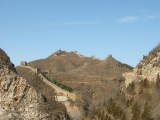 The next day it was time to check out another great attraction: The
Great Wall. We bought a day tour (lunch included) for RMB 380 each in
the hotel lobby with a company called ”Dragon bus tours”. We had read
quite a bit about the wall and we had hoped to walk from Jinshanling to
Simatai but our tour “only” included a 2 hour walk along Simatai.
The next day it was time to check out another great attraction: The
Great Wall. We bought a day tour (lunch included) for RMB 380 each in
the hotel lobby with a company called ”Dragon bus tours”. We had read
quite a bit about the wall and we had hoped to walk from Jinshanling to
Simatai but our tour “only” included a 2 hour walk along Simatai.
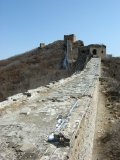 Most
tourists seem to go to the part of the wall called Badaling but we were
hoping to avoid the crowds and any queues. We were picked up at the
hotel at 9 am and apart from our driver and our guide Judy we were
accompanied by a couple of American girls. The drive to the Simatai
section takes about 2 hours each way. The long drive gave us a chance to
look out the windows and see how people live, people working along the
road and so on.
Most
tourists seem to go to the part of the wall called Badaling but we were
hoping to avoid the crowds and any queues. We were picked up at the
hotel at 9 am and apart from our driver and our guide Judy we were
accompanied by a couple of American girls. The drive to the Simatai
section takes about 2 hours each way. The long drive gave us a chance to
look out the windows and see how people live, people working along the
road and so on.
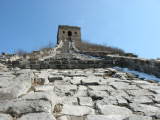 Once again we were very lucky with the weather and when
we reached the wall the skies were blue. Getting to the wall is really a
great moment. All of a sudden you can see the wall on the mountain tops
stretching as far as you can see, like a never-ending snake. As it was
so early in the season the cable car that usually takes people up to the
wall wasn’t running so we all had to walk up and that was OK with me. It
took us about 20 minutes just to reach the wall but all of a sudden we
had our feet on a part of world history. At Simatai you can choose if
you want to go to the left
Once again we were very lucky with the weather and when
we reached the wall the skies were blue. Getting to the wall is really a
great moment. All of a sudden you can see the wall on the mountain tops
stretching as far as you can see, like a never-ending snake. As it was
so early in the season the cable car that usually takes people up to the
wall wasn’t running so we all had to walk up and that was OK with me. It
took us about 20 minutes just to reach the wall but all of a sudden we
had our feet on a part of world history. At Simatai you can choose if
you want to go to the left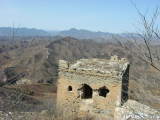 (I guess this takes you to Jinshanling) or to
the right where you have 15/16 watch towers before you reach the end and
it rise up about 1000 meters above sea level. We chose to walk on the
right part of the wall. As it was still only early spring, we saw bits
of snow left on the wall and in the landscape itself. The wall was
really steep in some places and sometimes the steps were narrow. To
start with we had some locals following us and they wanted to sell us
different stuff, but they eventually stopped tagging along. Time
constraints meant that I only got as far as tower 11, but the view just
got better and better the higher I got, and I got trigger happy with our
camera. The combination of a great view and the scarcity of other
(I guess this takes you to Jinshanling) or to
the right where you have 15/16 watch towers before you reach the end and
it rise up about 1000 meters above sea level. We chose to walk on the
right part of the wall. As it was still only early spring, we saw bits
of snow left on the wall and in the landscape itself. The wall was
really steep in some places and sometimes the steps were narrow. To
start with we had some locals following us and they wanted to sell us
different stuff, but they eventually stopped tagging along. Time
constraints meant that I only got as far as tower 11, but the view just
got better and better the higher I got, and I got trigger happy with our
camera. The combination of a great view and the scarcity of other
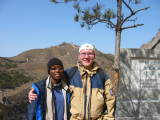 tourists made it a truly special experience. On the one hand it is
amazing to have walked on something that I have read so much about and
see so many pictures of. On the other hand it is hard not to think about
all the blood, sweat and tears that has gone into building this wall (in
fact it is not one wall but many walls that has been built in different
dynasties). Our guide told us that lots of people died in the process of
building it and many people were actually buried in the wall itself.
tourists made it a truly special experience. On the one hand it is
amazing to have walked on something that I have read so much about and
see so many pictures of. On the other hand it is hard not to think about
all the blood, sweat and tears that has gone into building this wall (in
fact it is not one wall but many walls that has been built in different
dynasties). Our guide told us that lots of people died in the process of
building it and many people were actually buried in the wall itself.
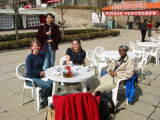 After
walking on the wall we went down to the parking lot again. Here you’ll
find lots of little shops and restaurant and we had lunch at one place.
We just sat down and they brought out lots of food. Whilst eating lunch,
we were quite surprised when all of a sudden a guy came running out of
the restaurant and dumped a live fish on the paved walkway not far from
us. Soon after a woman came out from the restaurant with a big knife and
beheaded and de-scaled the fish :-)
After
walking on the wall we went down to the parking lot again. Here you’ll
find lots of little shops and restaurant and we had lunch at one place.
We just sat down and they brought out lots of food. Whilst eating lunch,
we were quite surprised when all of a sudden a guy came running out of
the restaurant and dumped a live fish on the paved walkway not far from
us. Soon after a woman came out from the restaurant with a big knife and
beheaded and de-scaled the fish :-)
On the way out guide Judy asked if we wanted to go to the pearl market because it was on the way. It turned out that the market wasn’t really on the way and it was not the market that we thought it was. It was a shop that only sold things made from pearls. When we got there we were more or less the only guests in the store but about 15 clerks that were just waiting to sell us stuff. So we walked around for like 5 minutes before we left. I guess Dragon Bus tours get some money from the store by bringing people over like this and we have experienced the same in guided tours in Thailand. But it makes us feel a bit uncomfortable.
Chairman Mao’s memorial hall
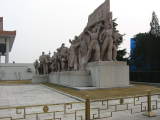 If
you want to see the remains of Chairman Mao you can go to his Memorial
hall located on the southern end of Tiananmen Square. We got in line
together with hundreds of Chinese people one morning. We soon found out
that we had to get out of the line due to our backpack. But after this
was handed in (on the other side of the main road of course) we got back
in line and we started walking in. Once we got into the memorial hall we
were told to be quiet (yes, I was chatting away :-) and we were asked to
show respect by removing our hats. You don’t really get a very good look
at Mao in his glass coffin because people are rushed through the room so
that the next group of people can come in. Visiting the memorial hall is
free and it was a bit of a strange experience :-)
If
you want to see the remains of Chairman Mao you can go to his Memorial
hall located on the southern end of Tiananmen Square. We got in line
together with hundreds of Chinese people one morning. We soon found out
that we had to get out of the line due to our backpack. But after this
was handed in (on the other side of the main road of course) we got back
in line and we started walking in. Once we got into the memorial hall we
were told to be quiet (yes, I was chatting away :-) and we were asked to
show respect by removing our hats. You don’t really get a very good look
at Mao in his glass coffin because people are rushed through the room so
that the next group of people can come in. Visiting the memorial hall is
free and it was a bit of a strange experience :-)
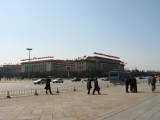 We also wanted to check out the Museum of the Revolution and maybe the
Great Hall of the People (the parliament). The parliament just had a
gathering, and the new President had recently been announced, so it was
basically closed all the time. But we decided to try out the Museum of
the Revolution. It seems like this has been changed a bit since the
guide book was written. It has now been spilt up into different small
museums and we went into two of them: one contains pieces that showed a
bit of China’s long history and another museum focusing on China’s World
heritage. It was not really easy to find out where to buy tickets to the
museums because they were selling them on both sides of the entrance.
This, combined with the fact that ”Chinese art students” kept on bugging
us to come along to look at their work, made it a bit confusing.
We also wanted to check out the Museum of the Revolution and maybe the
Great Hall of the People (the parliament). The parliament just had a
gathering, and the new President had recently been announced, so it was
basically closed all the time. But we decided to try out the Museum of
the Revolution. It seems like this has been changed a bit since the
guide book was written. It has now been spilt up into different small
museums and we went into two of them: one contains pieces that showed a
bit of China’s long history and another museum focusing on China’s World
heritage. It was not really easy to find out where to buy tickets to the
museums because they were selling them on both sides of the entrance.
This, combined with the fact that ”Chinese art students” kept on bugging
us to come along to look at their work, made it a bit confusing.
What to eat?
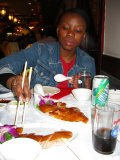 So what can you eat in Beijing? Well, there is of course one dish
that is famous and that is the Beijing (Peking) duck. We decided to try
out this dish at a place that was recommended by Kinareiser. We tried to
stick to the places that were recommended because there is a
communication problem if you walk into a restaurant where they don’t
speak English and where the menu is only in Chinese :-). King Roast Duck
Restaurant served a pretty good roasted duck and we paid about 200 RMB
(€ 25) for a meal for the 2 of us.
So what can you eat in Beijing? Well, there is of course one dish
that is famous and that is the Beijing (Peking) duck. We decided to try
out this dish at a place that was recommended by Kinareiser. We tried to
stick to the places that were recommended because there is a
communication problem if you walk into a restaurant where they don’t
speak English and where the menu is only in Chinese :-). King Roast Duck
Restaurant served a pretty good roasted duck and we paid about 200 RMB
(€ 25) for a meal for the 2 of us.
We also had lunch in a food court at a shopping mall. The Chinese dishes
were pretty
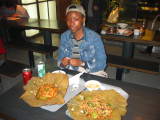 cheap and we paid like 15 RMB for one dish. But we also went
to western restaurants in the Wangfujing area (the main tourist area)
and here we experienced that the prices was more or less like back home.
It is also possible to get stuff like KFC and McDonald’s in different
locations around Beijing. It is always great fun to try to eat with
chopsticks by the way :-)…we did manage it somehow in the end but I guess
it is due to previous training in Singapore.
cheap and we paid like 15 RMB for one dish. But we also went
to western restaurants in the Wangfujing area (the main tourist area)
and here we experienced that the prices was more or less like back home.
It is also possible to get stuff like KFC and McDonald’s in different
locations around Beijing. It is always great fun to try to eat with
chopsticks by the way :-)…we did manage it somehow in the end but I guess
it is due to previous training in Singapore.
I mentioned the Wangfujing area where you’ll find some nice big hotels, big shopping malls and so on. The streets around here are very clean, well lit and look as if the Chinese are trying to appeal mainly to tourists. But you don’t have to go very far away from the main streets to find out that there is a different reality.
Transportation around Beijing
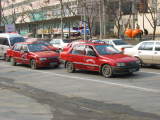 The best way to get around Beijing, in our opinion, is to take a
taxi. The majority of meter taxis are red with a little sticker on the
side with 1.20, 1.60, 2.00 and so on. This sticker indicates the
kilometre rate, and I guess (in theory at least) the better the car, the
more expensive the ride. The only challenge with the taxi drivers is
that most of them don’t speak English so just getting back to the hotel
can be a challenge :-)
The best way to get around Beijing, in our opinion, is to take a
taxi. The majority of meter taxis are red with a little sticker on the
side with 1.20, 1.60, 2.00 and so on. This sticker indicates the
kilometre rate, and I guess (in theory at least) the better the car, the
more expensive the ride. The only challenge with the taxi drivers is
that most of them don’t speak English so just getting back to the hotel
can be a challenge :-) 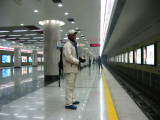 The best way to beat this challenge was to have the
hotel’s name and address on a business card to show to the taxi driver.Another way to get around is taking the subway for 3 RMB. At the moment
there are 3 lines: Line 1, Line 13 and the loop line. It was even
possible to take the subway from the Radisson SAS hotel but it took
about 15 minutes to walk to the nearest station (Liufang station on line
13). But the connection between the different lines was not all that
great and you have to buy another ticket when you switch from one line
to the other.
The best way to beat this challenge was to have the
hotel’s name and address on a business card to show to the taxi driver.Another way to get around is taking the subway for 3 RMB. At the moment
there are 3 lines: Line 1, Line 13 and the loop line. It was even
possible to take the subway from the Radisson SAS hotel but it took
about 15 minutes to walk to the nearest station (Liufang station on line
13). But the connection between the different lines was not all that
great and you have to buy another ticket when you switch from one line
to the other.
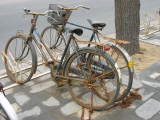 It is fascinating to see how traffic varies from country to country
around the world. I’m sure that it is possible to write an entire book
on the subject of driving patterns in different countries :-) China was
certainly different than other countries that we have been to. Not only
do you have to keep an eye out for other cars…you also need to keep an
eye on all the pedestrians and cyclists. And let me assure you: there
are quite a lot of bicycles in Beijing :-) The motorists and cyclists seem
to have achieved some form of harmony because the cyclists seemed
impartial to the somewhat dubious drivers next to them.
It is fascinating to see how traffic varies from country to country
around the world. I’m sure that it is possible to write an entire book
on the subject of driving patterns in different countries :-) China was
certainly different than other countries that we have been to. Not only
do you have to keep an eye out for other cars…you also need to keep an
eye on all the pedestrians and cyclists. And let me assure you: there
are quite a lot of bicycles in Beijing :-) The motorists and cyclists seem
to have achieved some form of harmony because the cyclists seemed
impartial to the somewhat dubious drivers next to them.
The Beijing drivers seem to think that the mirrors in the car are not for practical use. Cars change lanes without any hesitation (or indication) and it seems to be the car behind that needs to keep an eye out for this. Another fascinating thing is the use of the horn. After many rides in taxis I have reached a conclusion that there are at least three reasons for using the horn: the reactive horn use (you pulled out right in front of me and you are blocking me); the preventive horn use (don’t try to pull out in front of me…I’m coming with great speed and there is no room for you); lastly general horn use (there is so much traffic and I can’t change lanes or overtake any cars).
Acrobatics show
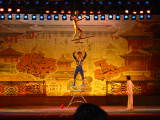 We
bought tickets in the hotel lobby at 120 RMB (about € 15) each for the
acrobatics show. The show was located close to the hotel and it started
at about 7.30 PM. I haven’t been to a show like this in years and it
reminded me a bit about stuff that you see in the circus. I was pretty
impressed with the show itself. Some of the stuff that was performed was
quite amazing. Just look at the picture on the right hand side. The man at the bottom is
balancing on a cylinder and the boy on top is doing the same. Looks
pretty dangerous if you ask me :-) The show lasted for about 1-1 ½ hours
and if you get thirsty or hungry you can buy snacks there during the
interval. We also thought about going to the Beijing opera but we never
really got around to that…maybe next time :-)
We
bought tickets in the hotel lobby at 120 RMB (about € 15) each for the
acrobatics show. The show was located close to the hotel and it started
at about 7.30 PM. I haven’t been to a show like this in years and it
reminded me a bit about stuff that you see in the circus. I was pretty
impressed with the show itself. Some of the stuff that was performed was
quite amazing. Just look at the picture on the right hand side. The man at the bottom is
balancing on a cylinder and the boy on top is doing the same. Looks
pretty dangerous if you ask me :-) The show lasted for about 1-1 ½ hours
and if you get thirsty or hungry you can buy snacks there during the
interval. We also thought about going to the Beijing opera but we never
really got around to that…maybe next time :-)
The art of spitting
We soon discovered that coughing up great wads of spit is a natural part
of the everyday life in Beijing. I’m not sure if people cough and spit
because of the air pollution or because they have a lot of dust being
blown in from the deserts in the north. It seems like there is quite a
lot of downfall in Beijing. I read somewhere that an average big city
gets about 8 tons of downfall pr square kilometre but Beijing gets about
18 tons. Well, I can tell you that it is noticeable…some days when I
blew my nose the tissue ended up kinda dirty…I shall not go into more
details :-)
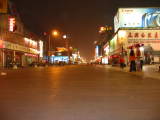 I’m not sure how common it is to see western tourists in Beijing. In the
Forbidden City, a guy came over to me and said something about taking a
picture. I thought he wanted me to take a picture of him and his friend
but it turned out that he wanted to take a picture of me and his friend.
Another day while I was walking in a shopping mall I saw two girls and
one of them had a camera. All of a sudden I was in the background of the
picture and I tried to hurry up because I didn’t want to ruin their
picture. But then all of a sudden the girls shifted position and once
again I was in the background of the picture. So I went over to them and
asked them if they wanted a picture of me and they said yes. So I ended
up taking a picture with both of them :-) But the question is: are western
tourists still so rare that Chinese wants to take pictures of them?
I’m not sure how common it is to see western tourists in Beijing. In the
Forbidden City, a guy came over to me and said something about taking a
picture. I thought he wanted me to take a picture of him and his friend
but it turned out that he wanted to take a picture of me and his friend.
Another day while I was walking in a shopping mall I saw two girls and
one of them had a camera. All of a sudden I was in the background of the
picture and I tried to hurry up because I didn’t want to ruin their
picture. But then all of a sudden the girls shifted position and once
again I was in the background of the picture. So I went over to them and
asked them if they wanted a picture of me and they said yes. So I ended
up taking a picture with both of them :-) But the question is: are western
tourists still so rare that Chinese wants to take pictures of them?
Summer Palace
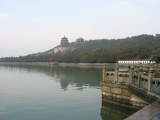 Another attraction that is recommended is the Summer Palace. Since
the hotel could only offer a guided tour which included 3 other
attractions in addition to the Summer Palace, we went there on our own.
The taxi ride took us less than half an hour and cost about 50 RMB. Once
we got out of the taxi we were ”bombarded” by people that were selling
stuff but we managed
Another attraction that is recommended is the Summer Palace. Since
the hotel could only offer a guided tour which included 3 other
attractions in addition to the Summer Palace, we went there on our own.
The taxi ride took us less than half an hour and cost about 50 RMB. Once
we got out of the taxi we were ”bombarded” by people that were selling
stuff but we managed
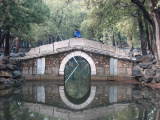 to get to the ticket counter and got entrance
tickets for 40 RMB each. I do wish that we had gone for some sort of
guiding here because we walked around more or less clueless. There is
some information at some of the buildings but most of them just kept on
repeating that the buildings had been burnt down by the Anglo-French
army in the 1860s.
to get to the ticket counter and got entrance
tickets for 40 RMB each. I do wish that we had gone for some sort of
guiding here because we walked around more or less clueless. There is
some information at some of the buildings but most of them just kept on
repeating that the buildings had been burnt down by the Anglo-French
army in the 1860s.
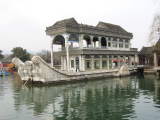 We also found some information in the guidebook but
it didn’t seem like enough. We walked around quite a lot and we got to
see the long corridor where about 1000 beams contain unique paintings.
We got to see the Tower of Buddhist Fragrance which towered over the
lake itself.
We also found some information in the guidebook but
it didn’t seem like enough. We walked around quite a lot and we got to
see the long corridor where about 1000 beams contain unique paintings.
We got to see the Tower of Buddhist Fragrance which towered over the
lake itself.
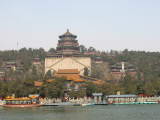 The steps leading up to this building are steep but the
view from the top is quite
nice. We also got to see the Marble Boat of
Purity and Ease – Empress Dowager Ci’xi’s way of honouring the navy
(paid for with naval funds). Many of the buildings in the complex are
not open to the public. One can peer through the dusty windows to see
the objects within – such as the Empress Dowager Ci’xi’s birthday gifts
in her birthday room.
The steps leading up to this building are steep but the
view from the top is quite
nice. We also got to see the Marble Boat of
Purity and Ease – Empress Dowager Ci’xi’s way of honouring the navy
(paid for with naval funds). Many of the buildings in the complex are
not open to the public. One can peer through the dusty windows to see
the objects within – such as the Empress Dowager Ci’xi’s birthday gifts
in her birthday room.
Lama temple
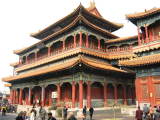 One day Nikki had a business appointment so I wandered of by myself
to find the Lama temple. It was not really difficult to find: you just
take the Beijing subway to Yonghe Gong on the loop line and there it is
:-) This used to be an imperial palace but it was turned into a lamasery
at one point. Today it is both a lamasery, a place of worship and a
tourist attraction. There are quite a lot of Buddha images in this place
and people are praying and lighting their incense. I always feel a bit
uncomfortable walking around amongst people praying because I feel like
I’m disturbing them in their religious act but they didn’t seem to mind.
The most impressive part of the Lama temple is the Pavilion of the ten
thousand fortunes which contains a 26 meter Buddha image supposedly
carved out of one single tree. The Buddha image was enormous and there
was even a little brass certificate on the outside that this was in the
Guinness book of records.
One day Nikki had a business appointment so I wandered of by myself
to find the Lama temple. It was not really difficult to find: you just
take the Beijing subway to Yonghe Gong on the loop line and there it is
:-) This used to be an imperial palace but it was turned into a lamasery
at one point. Today it is both a lamasery, a place of worship and a
tourist attraction. There are quite a lot of Buddha images in this place
and people are praying and lighting their incense. I always feel a bit
uncomfortable walking around amongst people praying because I feel like
I’m disturbing them in their religious act but they didn’t seem to mind.
The most impressive part of the Lama temple is the Pavilion of the ten
thousand fortunes which contains a 26 meter Buddha image supposedly
carved out of one single tree. The Buddha image was enormous and there
was even a little brass certificate on the outside that this was in the
Guinness book of records.
But I have to say that it is hard to get impressed by Buddhist temples after visiting some of the temples that you can find in Bangkok :-)
Shopping
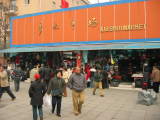 Before
I went to China I had heard rumours that you could get pretty cheap
copies of different stuff. So like most tourist we went to something
called the Xuishui Silk Market. The name is not very accurate by the
way…there are not much silk for sale but you can get North Face Gore-Tex
jackets, copies of watches, gloves…well, you name it. It is pretty easy
to get there by the way because this street is located right by the
subway station Yonganlin (if I’m not mistaken). Already before we
entered the market we were offered fake watches (two Rolex watches for
50 RMB). Once we got into the market there were little ”shops”
everywhere. Nikki looked at some pants and in the end she wanted to buy
2 of them. The woman selling it pointed at the price which was about 600
RMB per pants. In other words quite ridiculous because that is the price
of a pair of pants here in Norway. So we just walked off but the woman
came after us and dragged us back and asked how much we wanted to give
for the pants. So I punched in 300 RMB for both pants on her calculator
and she was acting away and saying that it was too cheap and it was
”killing” her. After a lot of bargaining we walked off again because she
did not seem to want to go low enough but then she came after us, gave
us the bag and took her 300 RMB and she did not look very happy. So the
price went down from 1200 to 300 RMB and I’m quite convinced that we
still got ripped off :-)
Before
I went to China I had heard rumours that you could get pretty cheap
copies of different stuff. So like most tourist we went to something
called the Xuishui Silk Market. The name is not very accurate by the
way…there are not much silk for sale but you can get North Face Gore-Tex
jackets, copies of watches, gloves…well, you name it. It is pretty easy
to get there by the way because this street is located right by the
subway station Yonganlin (if I’m not mistaken). Already before we
entered the market we were offered fake watches (two Rolex watches for
50 RMB). Once we got into the market there were little ”shops”
everywhere. Nikki looked at some pants and in the end she wanted to buy
2 of them. The woman selling it pointed at the price which was about 600
RMB per pants. In other words quite ridiculous because that is the price
of a pair of pants here in Norway. So we just walked off but the woman
came after us and dragged us back and asked how much we wanted to give
for the pants. So I punched in 300 RMB for both pants on her calculator
and she was acting away and saying that it was too cheap and it was
”killing” her. After a lot of bargaining we walked off again because she
did not seem to want to go low enough but then she came after us, gave
us the bag and took her 300 RMB and she did not look very happy. So the
price went down from 1200 to 300 RMB and I’m quite convinced that we
still got ripped off :-)
As I mentioned Gore-Tex jackets are being sold at this market. I doubt that they are real and hence it is hard to say anything about the quality. I came across Gore-Tex jackets of the Norwegian brand Norrøna. And I was wearing my own Norrøna jacket so it was easy to compare them. The jacket had been copied down to the last details and even the washing instructions were in Norwegian. So I have to say that I’m impressed but I could spot some differences.
If you want to buy fake watches this is also the place to go. Here you can find fake watches like Tag Heuer, Breitling, IWC, Lange & Söhne, Omega, Rolex and so on and some of them actually contain automatic movements…so it is more or less ”real fake” watches as one of my colleagues once said. But the price of some of these watches started quite high. I looked at a Lange & Söhne watch and the seller wanted 750 RMB for it.
We also went to some of the malls that are located in the Wangfujing area. But we felt that there really was no point in going shopping there. The prices were more or less on the same price level as back home and they didn’t really have a great selection.
Time went fast in Beijing and all of a sudden we had reached Saturday March 22nd. It was time to go to Xi'an by train. Follow this link to read the rest of the travelogue (from Xi'an and Hong Kong)